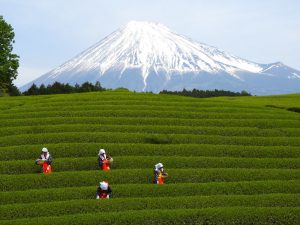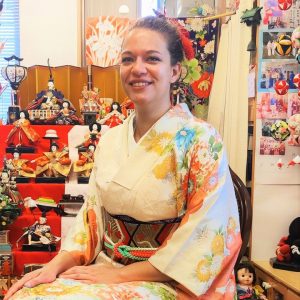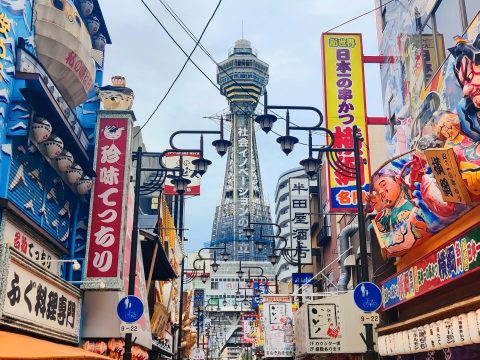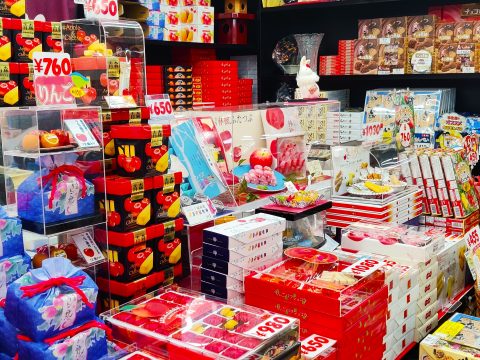Visiting a Green Tea Farm
JAPANESE FOODS
28.05.2025

If you ask anyone in the world what Japan’s most famous drink is, there’s a big chance that they will say ‘green tea’, or more specifically ‘matcha’. Especially for the past few years, matcha has taken over the world, which recently even resulted in a matcha shortage. But let’s start at the beginning: the tea leaves which are grown on farms all over Japan.
My first tea farm experience
Did you know that you can visit many of these farms? I first visited a tea farm back in 2019, when I came across an advertisement for their annual ‘Tea Festival’. It was a unique experience with ladies in traditional clothing posing for the photo contest, tea tastings, tea leaf tempura and of course the most spectacular view of Mt. Fuji behind the bright green tea fields.
Due to its perfect location and long history, this farm is often used for tea commercials. This month, I decided to return to the same farm in Shizuoka prefecture on a random weekend and it was very peaceful, quiet, and still as stunning as I remembered.
What to do at a tea farm?
Shizuoka prefecture is responsible for producing over 40% of Japan’s various green teas, but mainly sencha. The famous Uji area, in Kyoto prefecture is the runner up and mainly produces matcha. As you might expect, these farms can usually only be reached by car. However, guided tours including transportation are becoming more common.
Each farm also has different visiting policies. Some farms you can visit freely within specified opening hours, while others require a reservation. Depending on the farm, you can enjoy various activities, such as simply walking around while taking pictures, joining a guided tour, attending a tea ceremony or even dressing up in traditional farmers’ clothing and harvesting some tea leaves yourself. But there is one experience which every farm offers: tea tasting.

Tea Tasting
Whether it’s one small cup of tea or a variety of teas, the staff will proudly (and often free of charge) pour you some tea to enjoy, right at the farm where it all started. Depending on the number of staff members and whether you book a guided tour or not, you can usually get more explanation about green tea.
There are so many different types of green tea in Japan, which can seem complicated and overwhelming. So let’s have a look at the farm-to-teapot process of all these different teas.

Green Tea 101
After harvesting, the leaves are quickly processed, to maintain the freshness and quality of the leaves. They are steamed, cooled, kneaded, and finally dried. As mentioned before, sencha is the most common type of green tea in Japan, with the leaves being grown in the sun.
But there are also different types of sencha and the flavor and aroma are influenced greatly by the duration of the steaming process. The longer the leaves get steamed, the richer the taste and darker the color. Asamushi sencha for example, gets steamed for only 20 to 30 seconds, chumushi sencha for about 60 seconds and fukamushi sencha for about 120 seconds.
By changing the process, these same leaves can become houjicha by roasting the leaves or oolongcha by fermenting them. Besides that, kukicha can be made by using the stems instead of the leaves, and genmaicha is a mixture of sencha (or the later harvested and therefore lower grade tea bancha) and roasted, puffed rice. Leaves that are grown in the shade, but are processed in the same way as sencha, become gyokuro tea.
These same leaves are used for matcha, but the stems are removed and the leaves are thoroughly stone-ground after steaming. Not to mention the impact that the season, location, temperature, altitude, water quality, and many other conditions have on the leaves before harvesting.

Isn’t it amazing how tea leaves that are all grown in one farm, can result in so many types of tea? They all have their own unique flavors, aromas and health benefits. So next time that you’re thinking of trying a new experience or want to take a day trip, why not visit a tea farm?

Mietta Varszegi
Mietta grew up in the Netherlands and moved to Japan in 2019 to work as an English teacher. Now, she has 3 different jobs, explores Tokyo on days off and takes trips around Japan whenever she can. But everywhere in Japan, the goal is the same: visit as many shrines, castles and parks as possible and eat everything!
Read previous articles by the writer
Read latest articles
KEYWORDS
- # PICKPICK
- # Resume
- # alcohol
- # Rice
- # Soup
- # winter food
- # Fast Food
- # seafood
- # spicy foods
- # raw food
- # fermented food
- # Transportation
- # MEAT
- # Edo culture
- # suits
- # clothing
- # drink
- # fish
- # seasoning
- # Japanese New Years Foods
- # Toshikoshi soba
- # Osechi Ryori
- # Ozoni
- # Christmas
- # Japanese fusion pasta
- # Wafu Pasta
- # Japanese Hot Pot
- # なべ
- # 鍋
- # Miyazaki
- # Chicken Nanban
- # Karamen
- # Autumn Wagashi
- # Mushi-yokan
- # Imo-yokan
- # Japanese Autumn Fruits
- # Autumn
- # Vending Machine
- # fall
- # dango
- # Chestnut rice
- # saury
- # Mushroom
- # Rice vinegar
- # Japanese condiments
- # 調味料
- # Sake
- # Mirin
- # Soy sauce
- # Japanese Noodles
- # Udon
- # Ramen
- # Yakisoba
- # Soba
- # Japanese Seaweed
- # 海藻
- # かいそう
- # Payslip
- # Training
- # Japanese summer foods
- # 和菓子
- # Wagashi
- # ryokucha
- # 夏
- # 飲み物
- # Ramune
- # ラムネ
- # Pokari Sweat
- # ポカリスエット
- # Calpis
- # カルピス
- # Mugicha
- # ume
- # 梅
- # うめ
- # umeshu
- # job hunting
- # tofu
- # Recruitment in Japan
- # miso
- # Japanese cuisine
- # Yellowtail and bonito
- # Children’s Day
- # Kashiwa Mochi
- # Chimaki
- # fruits
- # Kusamochi
- # Types of Agriculture in Japan
- # bread
- # パン
- # パン屋さん
- # japanese bread
- # shokupan
- # meal blead
- # anko bread
- # 桜
- # さくら
- # cherry blossom
- # visa
- # hanami
- # omotenashi
- # sakura
- # おもてなし
- # Japanese hospitality
- # oshibori
- # wet hand towel
- # hand towel
- # restaurant
- # Commuting in Japan
- # Women-only cars
- # Exit gate
- # japanese train
- # train
- # valentine
- # Japanese sweets
- # 朝食
- # Japanese Breakfast
- # Breakfast
- # Japanese
- # 日本
- # healthy
- # persimmons
- # hoshigaki
- # HR
- # work in Japan
- # jinji ido
- # corporate systems
- # Japanese work culture
- # bento
- # ekiben
- # shinkansen
- # omiyage
- # train station
- # Japanese culture
- # work culture
- # mentaiko
- # umeboshi
- # Japanese snacks
- # potato chips
- # Japanese potato chips
- # Japanese writing
- # seaweed
- # konbu
- # ocean foods
- # shio konbu
- # dashi
- # miso soup
- # food processing
- # pear
- # nashi
- # sweet potato
- # japanese sweet potato
- # stingray
- # satsuma imo
- # food value chain
- # homecooking
- # agriculture
- # Japanese homecooking
- # farming
- # nikujaga
- # shojin ryori
- # meat and potatoes
- # traditional foods
- # comfort food
- # buddhist food
- # manufacturing
- # factory
- # eihire
- # vegetarian
- # food and beverage
- # izakaya
- # yatai
- # japanese festival
- # taiyaki
- # matsuri
- # summer
- # Ikayaki
- # smart agriculture
- # shaved ice
- # kakigori
- # かき氷
- # summer dessert
- # Japan
- # Japanese foods
- # dessert
- # fruit
- # matcha
- # icecream
- # Pikcup
- # Pikc up
- # Pcikup
- # skilled labor visa
- # working visa japan
- # Dineer Table in Japan
- # Japanese manner
- # Japanese food
- # Japanese Table Manner
- # Chopsticks
- # Japanese traffic signs
- # traffic information
- # road rules in Japan
- # chocolate
- # green tea
- # Osaka
- # Work Japan
- # Japanese company
- # ikura
- # sushi
- # nigiri
- # wasabi
- # PCIK
- # PICK UP
- # PICK
- # PICKUP







